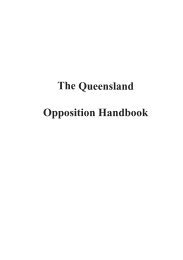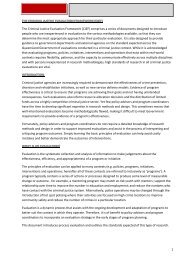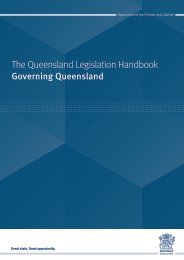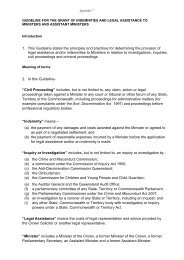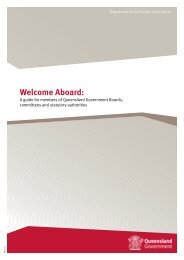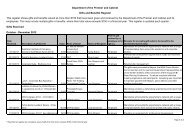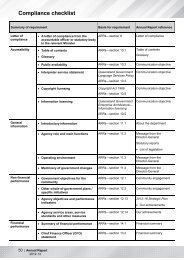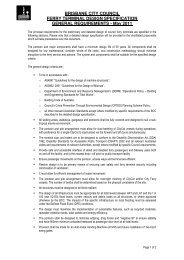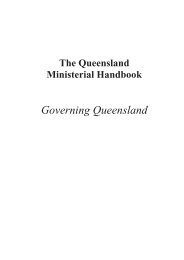Rehabilitative needs and treatment of Indigenous offenders in ...
Rehabilitative needs and treatment of Indigenous offenders in ...
Rehabilitative needs and treatment of Indigenous offenders in ...
You also want an ePaper? Increase the reach of your titles
YUMPU automatically turns print PDFs into web optimized ePapers that Google loves.
Further analysis shows that both male <strong>and</strong> female <strong>Indigenous</strong> <strong>of</strong>fenders aremore likely than non-<strong>Indigenous</strong> <strong>of</strong>fenders to have a sentence that <strong>in</strong>volves abreach <strong>of</strong> Domestic Violence Order or a breach <strong>of</strong> Bail Act <strong>of</strong>fence. Forsentenced <strong>of</strong>fenders admitted <strong>in</strong>to custody after 30 June 2004, 10 per cent <strong>of</strong>female <strong>Indigenous</strong> <strong>of</strong>fenders <strong>and</strong> one per cent <strong>of</strong> female non-<strong>Indigenous</strong><strong>of</strong>fenders are <strong>in</strong> custody at 30 June 2009 for <strong>of</strong>fences that <strong>in</strong>clude a breach <strong>of</strong>a Domestic Violence Order. Twenty-five per cent <strong>of</strong> male <strong>Indigenous</strong><strong>of</strong>fenders <strong>and</strong> 10 per cent <strong>of</strong> male non-<strong>Indigenous</strong> <strong>of</strong>fenders are <strong>in</strong> custody for<strong>of</strong>fences that <strong>in</strong>clude a breach <strong>of</strong> a Domestic Violence Order. The same dataanalysis also shows that 32 per cent <strong>of</strong> female <strong>Indigenous</strong> <strong>of</strong>fenders <strong>and</strong> 18per cent <strong>of</strong> female non-<strong>Indigenous</strong> <strong>of</strong>fenders have a breach <strong>of</strong> Bail Act <strong>of</strong>fenceat 30 June 2009. The figures for male <strong>Indigenous</strong> <strong>of</strong>fenders <strong>and</strong> male non-<strong>Indigenous</strong> <strong>of</strong>fenders are 17 per cent <strong>and</strong> 29 per cent respectively.Table 4.2: Most Serious Offence as at 30 June 2009Most Serious Offence/ChargeMale (%) With<strong>in</strong> MSONon-<strong>Indigenous</strong> <strong>Indigenous</strong>Female (%) With<strong>in</strong> MSONon-<strong>Indigenous</strong> <strong>Indigenous</strong>TotalMSO(%)Homicide <strong>and</strong> related <strong>of</strong>fences 16.9 75.7 1.3 6.0 10.6Acts <strong>in</strong>tended to cause <strong>in</strong>jury 40.9 51.5 5.1 2.5 20.9Sexual assault <strong>and</strong> related <strong>of</strong>fences 26.6 72.7 0.1 0.6 15.5Dangerous <strong>and</strong> negligent actsendanger<strong>in</strong>g persons 25.7 65.3 3.0 5.9 1.8Abduction <strong>and</strong> related <strong>of</strong>fences 35.0 60.0 0.0 5.0 0.4Robbery, extortion <strong>and</strong> related<strong>of</strong>fences 20.4 75.0 2.0 2.7 9.0Unlawful entry with <strong>in</strong>tent/burglary,break <strong>and</strong> enter 28.0 66.7 1.8 3.5 13.0Theft <strong>and</strong> related <strong>of</strong>fences 26.1 57.0 1.9 15.0 3.7Deception <strong>and</strong> related <strong>of</strong>fences 3.5 60.8 1.8 33.9 4.0Illicit drug <strong>of</strong>fences 3.7 87.7 0.4 8.2 9.0Weapons <strong>and</strong> explosives <strong>of</strong>fences 0.0 89.5 5.3 5.3 0.3Property damage <strong>and</strong>environmental pollution 16.5 77.1 2.8 3.7 1.9Public order <strong>of</strong>fences 29.6 63.0 3.7 3.7 0.5Road traffic <strong>and</strong> motor vehicleregulatory <strong>of</strong>fences 29.5 64.6 0.7 5.2 4.7Offences aga<strong>in</strong>st justiceprocedures, government security<strong>and</strong> government operations 48.8 44.5 1.9 4.8 3.7Miscellaneous <strong>of</strong>fences 14.8 81.5 0.0 3.7 1.0Total <strong>Indigenous</strong> Status (%) 25.8 66.9 2.0 5.3 100.0Total <strong>Indigenous</strong> Status (n) 1460 3791 116 300 5667Source: QCS, IOMSNB: For sentenced prisoners, the most serious <strong>of</strong>fence is the <strong>of</strong>fence for which the prisoner has received the longestsentence <strong>in</strong> this episode.For unsentenced prisoners, the most serious charge is the charge which carries the longest statutory maximumpenalty.Where sentences or penalties are equal, the most serious <strong>of</strong>fence/charge is the <strong>of</strong>fence/charge with the lowestAustralian St<strong>and</strong>ard Offence Classification (ASOC).28



